Insect & Tick Control

Resources for Mosquito Control from Jefferson County General Health District
Jefferson County General Health District offers resources for mosquito control in Ohio. Review the information or call us at (740) 283-8530 with any questions.
Tips to Avoid Mosquitoes
In order to avoid mosquito-borne illness, you must avoid being bit by a mosquito. Some tips to avoid these pests include:
– Remember to Drain, Dress, and Defend
– Use EPA-registered insect repellents on exposed skin
– Wear light-colored clothing, long-sleeved shirts and jackets, and long pants
– Try to avoid being outdoors during peak mosquito biting hours
– Use netting when sleeping outdoors
When using repellents, be sure to read over the application instructions carefully.

How to Plan for Mosquitoes When Traveling
Planning on traveling this season? Follow these packing tips to heighten safety against mosquitoes:
– Bring EPA-registered insect repellent
– Wear permethrin or other EPA-registered clothing treatments
– Bring light-colored clothing, long-sleeved shirts, and long pants
– Bring netting if sleeping outdoors

How to Stop Mosquitoes from Breeding in Your Home
Mosquitoes can breed in and around your home without you noticing until it is too late. Follow these steps to make protect your home from mosquitoes:
– Empty standing water from buckets, barrels, flowerpots, tarps, and other items outdoors
– Discard trash like tin cans, plastic containers, and other water-holding containers
– Change water in pet dishes often
– Make sure there are no old tires on your property
– Aerate ornamental pools or stock them with mosquito-eating fish
– Clean and chlorinate swimming pools
– If possible, use air conditioning
– Replace water in bird baths frequently
– Check and clean gutters to make sure they are draining properly
For more tips on how to keep mosquitoes away from your home, contact Jefferson County General Health District today.

Bed Bugs

What are bed bugs?
Bed bugs are small, flat, parasitic insects that feed solely on the blood of people and animals while they sleep. Bed bugs are reddish-brown in color, wingless, range from 1mm to 7mm, and can live several months without a blood meal.
Where are bed bugs found?
Bed bug infestations usually occur around or near the areas where people sleep. These areas include apartments, shelters, rooming houses, hotels, cruise ships, buses, trains, and dorm rooms. They hide during the day in places such as seams of mattresses, box springs, bed frames, headboards, dresser tables, inside cracks or crevices, behind wallpaper, or any other clutter or objects around a bed. Bed bugs have been shown to be able to travel over 100 feet in a night but tend to live within 8 feet of where people sleep.
Do bed bugs spread disease?
Bed bugs are not known to spread disease. Bed bugs can be an annoyance because their presence may cause itching and loss of sleep. Sometimes the itching can lead to excessive scratching that can sometimes increase the chance of a secondary skin infection.
What are the signs and symptoms of a bed bug infestation?
One of the easiest ways to identify a bed bug infestation is by the tell-tale bite marks on the face, neck, arms, hands, or any other body parts while sleeping. However, these bite marks may take as long as 14 days to develop in some people so it is important to look for other clues when determining if bed bugs have infested an area. These signs include: the bed bugs’ exoskeletons after molting, bed bugs in the fold of mattresses and sheets, rusty–colored blood spots due to their blood-filled fecal material that they excrete on the mattress or nearby furniture, and a sweet musty odor.
How did I get bed bugs?
Bed bugs are experts at hiding. Their slim flat bodies allow them to fit into the smallest of spaces and stay there for long periods of time, even without a blood meal. Bed bugs are usually transported from place to place as people travel. The bed bugs travel in the seams and folds of luggage, overnight bags, folded clothes, bedding, furniture, and anywhere else where they can hide. Most people do not realize they are transporting stow-away bed bugs as they travel from location to location, infecting areas as they travel.
Who is at risk for getting bed bugs?
Everyone is at risk for getting bed bugs when visiting an infected area. However, anyone who travels frequently and shares living and sleeping quarters where other people have previously slept has a higher risk of being bitten and or spreading a bed bug infestation.
How are bed bugs treated and prevented?
Bed bug bites usually do not pose a serious medical threat. The best way to treat a bite is to avoid scratching the area and apply antiseptic creams or lotions and take an antihistamine. Bed bug infestations are commonly treated by insecticide spraying. If you suspect that you have an infestation, contact your landlord or professional pest control company that is experienced with treating bed bugs. The best way to prevent bed bugs is regular inspection for the signs of an infestation.
Source: CDC – Bed Bugs
JCGHD cannot force a landlord to pay for treatment. JCGHD cannot intervene in a legal dispute between a tenant and landlord about who is responsible for paying for treatment.

Ticks
Ticks are another dangerous pest that can cause diseases like Lyme disease. View the following resources from the CDC to stay safe from ticks and to learn what to do if you find a tick on you.
Protect against tick bites!
Avoid wooded and brushy areas with high grass and leaf litter
- Walk in the center of trails.
- Take extra precautions in spring, summer and fall when ticks are most active.
Use tick repellents
- Use repellents registered by the U.S. EPA labeled for use against ticks on exposed skin for protection that lasts several hours. Always follow the product label. Parents should apply this product to their children, avoiding their hands, eyes, and mouth.
- Treat clothing and gear, such as boots, pants, socks, and tents with products containing 0.5 percent permethrin. It remains protective through several washings. Always follow the product label. Pre-treated clothing is available and may provide longer lasting protection.
Cover up to keep ticks off your body
- Wear long pants, long sleeves, and long socks.
- Tuck pant legs into socks or boots and tuck shirts into pants to keep ticks on the outside of your clothing.
- Light-colored clothing will help you spot ticks more easily.

